Working Capital Management and Profitability in the Retail Sector
VerifiedAdded on 2020/12/09
|8
|1481
|342
Report
AI Summary
This business report proposal investigates the influence of working capital management on the profitability of firms within the retail sector. It begins by outlining the background, research aim, objectives, and questions, emphasizing the significance of working capital management in the retail context. The study aims to assess how working capital influences profitability in leading retail business units. The research methodology involves a quantitative approach, utilizing secondary data from annual reports and academic literature, with a focus on five major UK retail companies: Tesco, Morrison’s, Sainsbury, Marks & Spencer, and Next Plc. Statistical tools like regression and correlation analysis will be used to analyze the data. The report includes a detailed timeline for the research, from topic selection to final submission, and provides a comprehensive literature review of working capital management and its impact on business performance. The proposal concludes with a list of cited references, providing a foundation for the study's credibility and relevance to the retail sector.
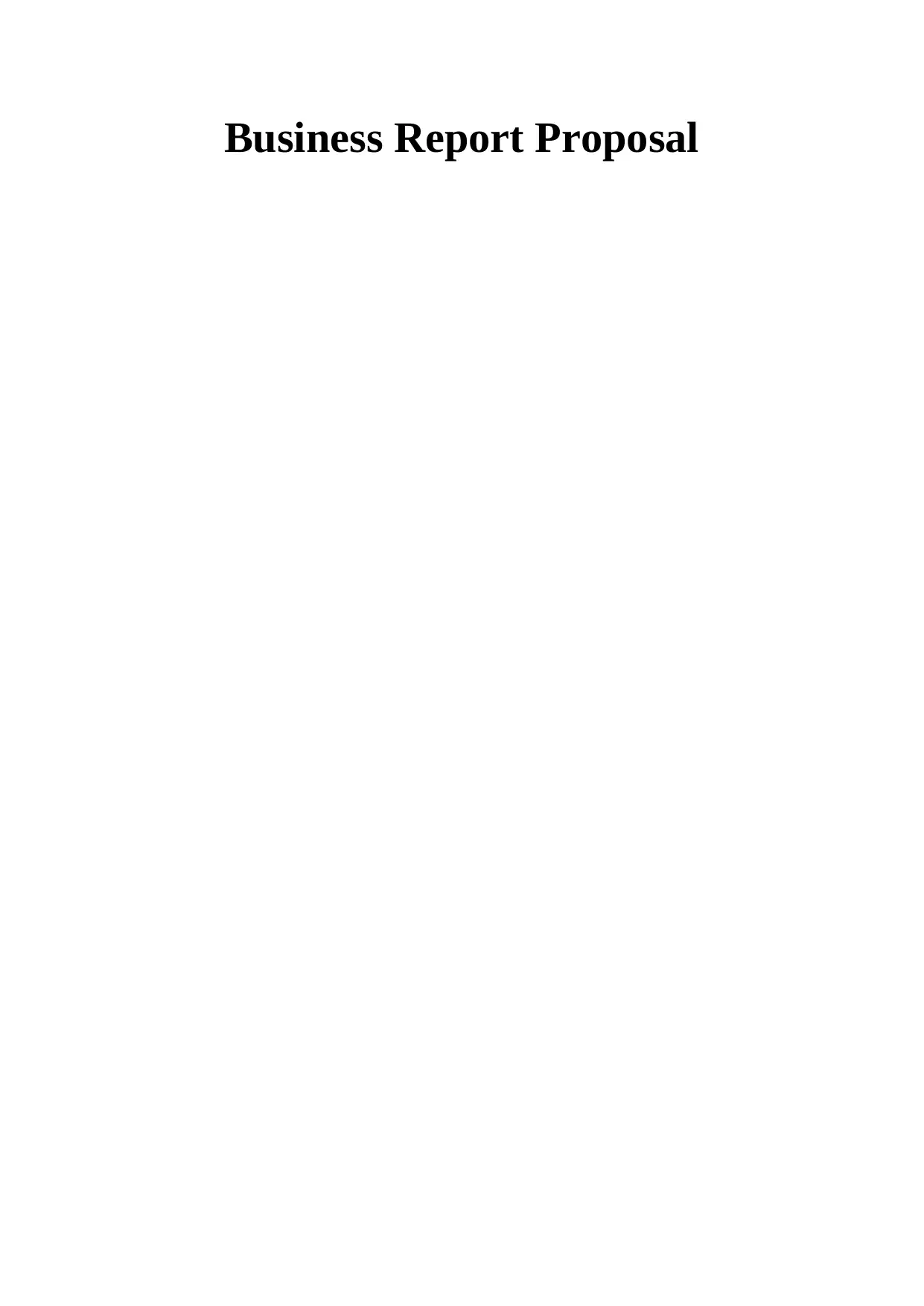
Business Report Proposal
Paraphrase This Document
Need a fresh take? Get an instant paraphrase of this document with our AI Paraphraser
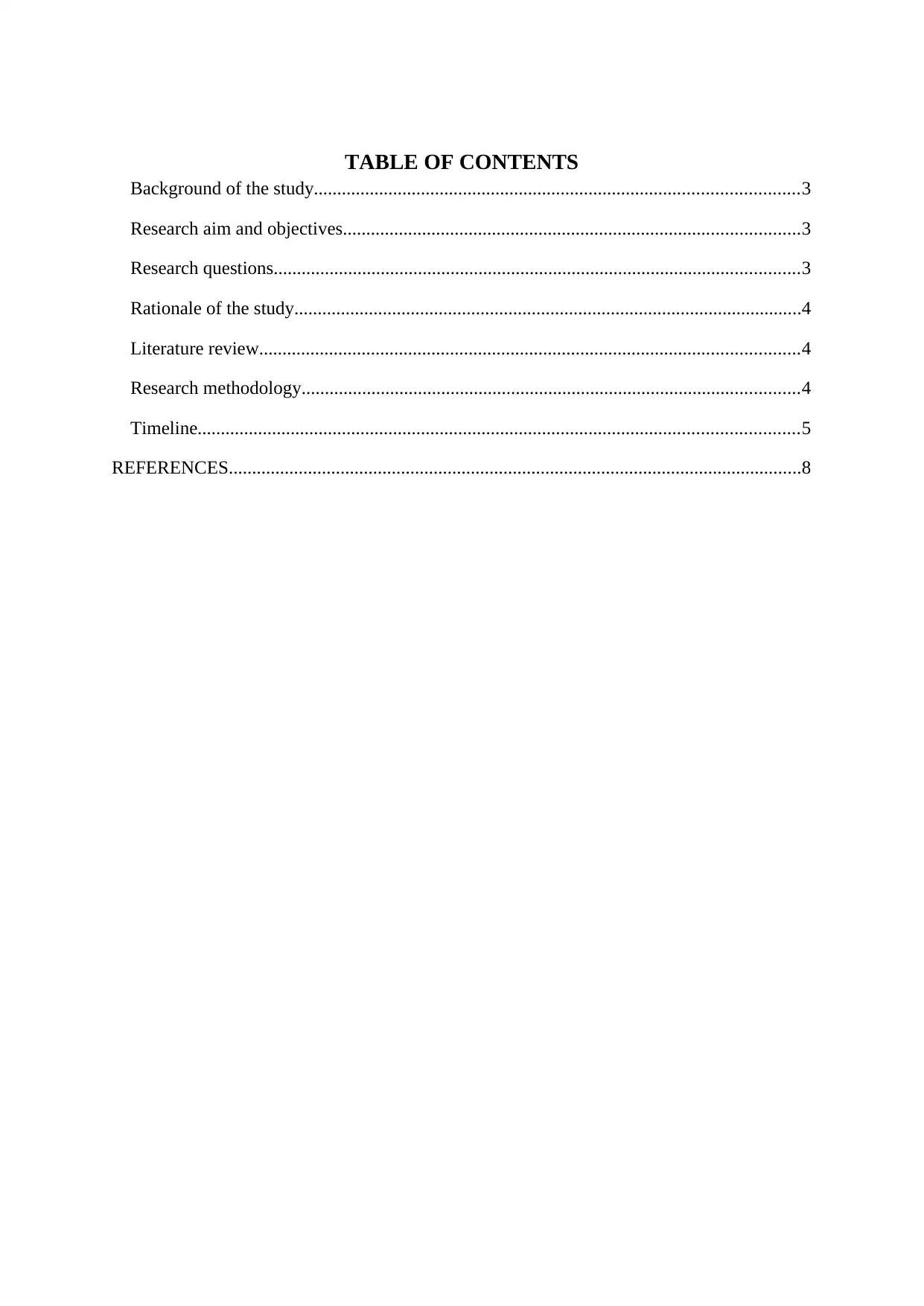
TABLE OF CONTENTS
Background of the study........................................................................................................3
Research aim and objectives..................................................................................................3
Research questions.................................................................................................................3
Rationale of the study.............................................................................................................4
Literature review....................................................................................................................4
Research methodology...........................................................................................................4
Timeline.................................................................................................................................5
REFERENCES...........................................................................................................................8
Background of the study........................................................................................................3
Research aim and objectives..................................................................................................3
Research questions.................................................................................................................3
Rationale of the study.............................................................................................................4
Literature review....................................................................................................................4
Research methodology...........................................................................................................4
Timeline.................................................................................................................................5
REFERENCES...........................................................................................................................8
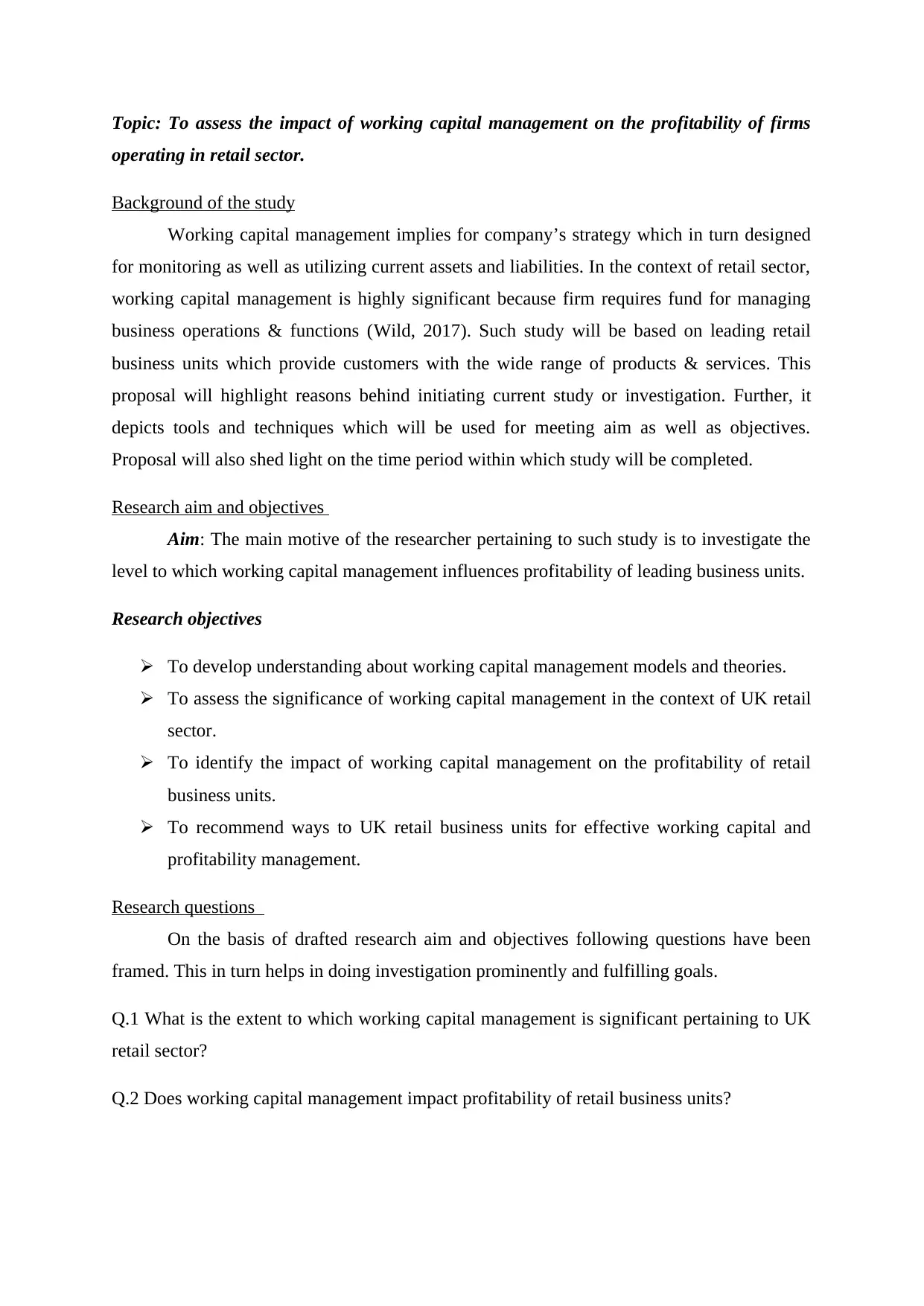
Topic: To assess the impact of working capital management on the profitability of firms
operating in retail sector.
Background of the study
Working capital management implies for company’s strategy which in turn designed
for monitoring as well as utilizing current assets and liabilities. In the context of retail sector,
working capital management is highly significant because firm requires fund for managing
business operations & functions (Wild, 2017). Such study will be based on leading retail
business units which provide customers with the wide range of products & services. This
proposal will highlight reasons behind initiating current study or investigation. Further, it
depicts tools and techniques which will be used for meeting aim as well as objectives.
Proposal will also shed light on the time period within which study will be completed.
Research aim and objectives
Aim: The main motive of the researcher pertaining to such study is to investigate the
level to which working capital management influences profitability of leading business units.
Research objectives
To develop understanding about working capital management models and theories.
To assess the significance of working capital management in the context of UK retail
sector.
To identify the impact of working capital management on the profitability of retail
business units.
To recommend ways to UK retail business units for effective working capital and
profitability management.
Research questions
On the basis of drafted research aim and objectives following questions have been
framed. This in turn helps in doing investigation prominently and fulfilling goals.
Q.1 What is the extent to which working capital management is significant pertaining to UK
retail sector?
Q.2 Does working capital management impact profitability of retail business units?
operating in retail sector.
Background of the study
Working capital management implies for company’s strategy which in turn designed
for monitoring as well as utilizing current assets and liabilities. In the context of retail sector,
working capital management is highly significant because firm requires fund for managing
business operations & functions (Wild, 2017). Such study will be based on leading retail
business units which provide customers with the wide range of products & services. This
proposal will highlight reasons behind initiating current study or investigation. Further, it
depicts tools and techniques which will be used for meeting aim as well as objectives.
Proposal will also shed light on the time period within which study will be completed.
Research aim and objectives
Aim: The main motive of the researcher pertaining to such study is to investigate the
level to which working capital management influences profitability of leading business units.
Research objectives
To develop understanding about working capital management models and theories.
To assess the significance of working capital management in the context of UK retail
sector.
To identify the impact of working capital management on the profitability of retail
business units.
To recommend ways to UK retail business units for effective working capital and
profitability management.
Research questions
On the basis of drafted research aim and objectives following questions have been
framed. This in turn helps in doing investigation prominently and fulfilling goals.
Q.1 What is the extent to which working capital management is significant pertaining to UK
retail sector?
Q.2 Does working capital management impact profitability of retail business units?
⊘ This is a preview!⊘
Do you want full access?
Subscribe today to unlock all pages.

Trusted by 1+ million students worldwide
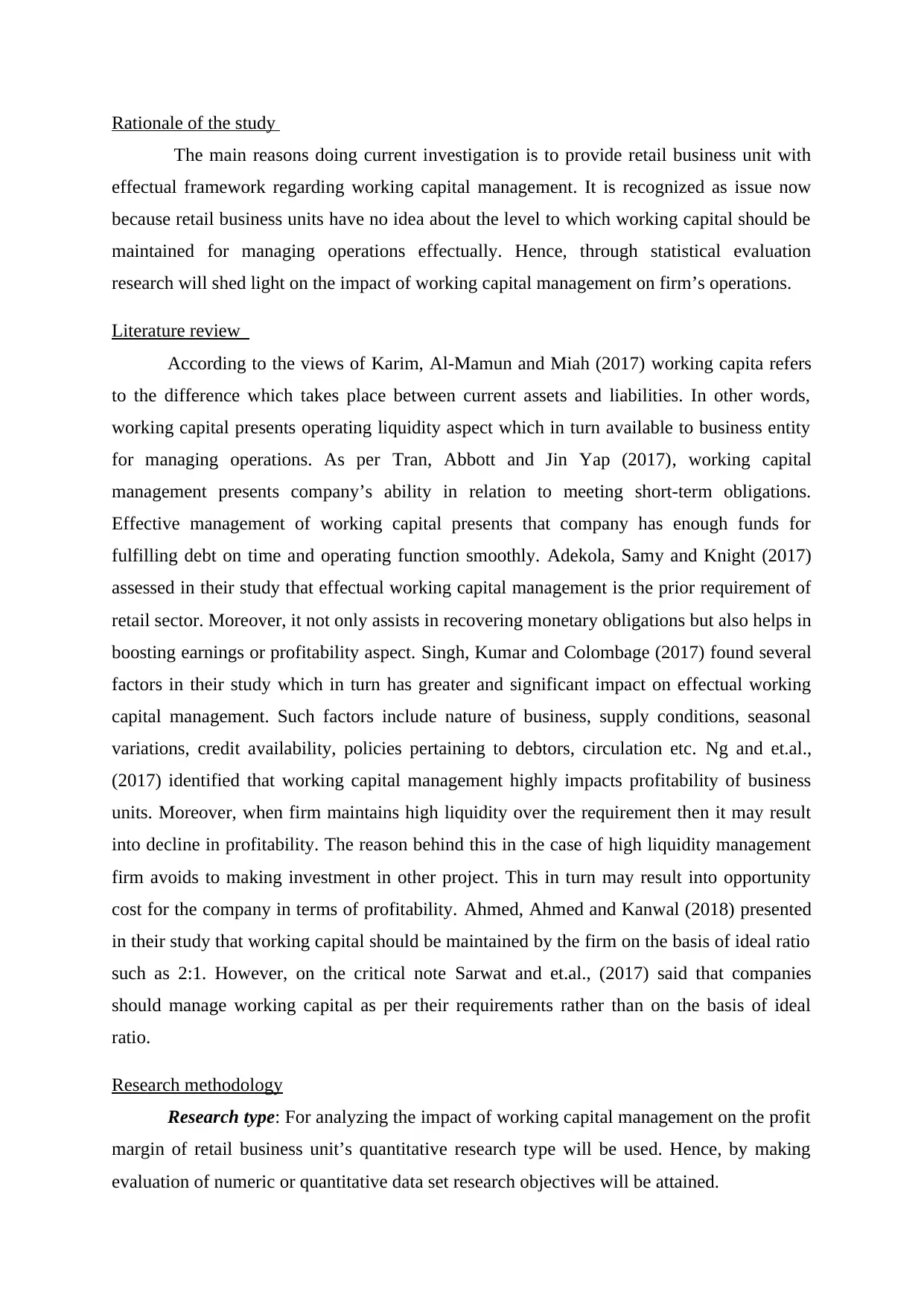
Rationale of the study
The main reasons doing current investigation is to provide retail business unit with
effectual framework regarding working capital management. It is recognized as issue now
because retail business units have no idea about the level to which working capital should be
maintained for managing operations effectually. Hence, through statistical evaluation
research will shed light on the impact of working capital management on firm’s operations.
Literature review
According to the views of Karim, Al-Mamun and Miah (2017) working capita refers
to the difference which takes place between current assets and liabilities. In other words,
working capital presents operating liquidity aspect which in turn available to business entity
for managing operations. As per Tran, Abbott and Jin Yap (2017), working capital
management presents company’s ability in relation to meeting short-term obligations.
Effective management of working capital presents that company has enough funds for
fulfilling debt on time and operating function smoothly. Adekola, Samy and Knight (2017)
assessed in their study that effectual working capital management is the prior requirement of
retail sector. Moreover, it not only assists in recovering monetary obligations but also helps in
boosting earnings or profitability aspect. Singh, Kumar and Colombage (2017) found several
factors in their study which in turn has greater and significant impact on effectual working
capital management. Such factors include nature of business, supply conditions, seasonal
variations, credit availability, policies pertaining to debtors, circulation etc. Ng and et.al.,
(2017) identified that working capital management highly impacts profitability of business
units. Moreover, when firm maintains high liquidity over the requirement then it may result
into decline in profitability. The reason behind this in the case of high liquidity management
firm avoids to making investment in other project. This in turn may result into opportunity
cost for the company in terms of profitability. Ahmed, Ahmed and Kanwal (2018) presented
in their study that working capital should be maintained by the firm on the basis of ideal ratio
such as 2:1. However, on the critical note Sarwat and et.al., (2017) said that companies
should manage working capital as per their requirements rather than on the basis of ideal
ratio.
Research methodology
Research type: For analyzing the impact of working capital management on the profit
margin of retail business unit’s quantitative research type will be used. Hence, by making
evaluation of numeric or quantitative data set research objectives will be attained.
The main reasons doing current investigation is to provide retail business unit with
effectual framework regarding working capital management. It is recognized as issue now
because retail business units have no idea about the level to which working capital should be
maintained for managing operations effectually. Hence, through statistical evaluation
research will shed light on the impact of working capital management on firm’s operations.
Literature review
According to the views of Karim, Al-Mamun and Miah (2017) working capita refers
to the difference which takes place between current assets and liabilities. In other words,
working capital presents operating liquidity aspect which in turn available to business entity
for managing operations. As per Tran, Abbott and Jin Yap (2017), working capital
management presents company’s ability in relation to meeting short-term obligations.
Effective management of working capital presents that company has enough funds for
fulfilling debt on time and operating function smoothly. Adekola, Samy and Knight (2017)
assessed in their study that effectual working capital management is the prior requirement of
retail sector. Moreover, it not only assists in recovering monetary obligations but also helps in
boosting earnings or profitability aspect. Singh, Kumar and Colombage (2017) found several
factors in their study which in turn has greater and significant impact on effectual working
capital management. Such factors include nature of business, supply conditions, seasonal
variations, credit availability, policies pertaining to debtors, circulation etc. Ng and et.al.,
(2017) identified that working capital management highly impacts profitability of business
units. Moreover, when firm maintains high liquidity over the requirement then it may result
into decline in profitability. The reason behind this in the case of high liquidity management
firm avoids to making investment in other project. This in turn may result into opportunity
cost for the company in terms of profitability. Ahmed, Ahmed and Kanwal (2018) presented
in their study that working capital should be maintained by the firm on the basis of ideal ratio
such as 2:1. However, on the critical note Sarwat and et.al., (2017) said that companies
should manage working capital as per their requirements rather than on the basis of ideal
ratio.
Research methodology
Research type: For analyzing the impact of working capital management on the profit
margin of retail business unit’s quantitative research type will be used. Hence, by making
evaluation of numeric or quantitative data set research objectives will be attained.
Paraphrase This Document
Need a fresh take? Get an instant paraphrase of this document with our AI Paraphraser
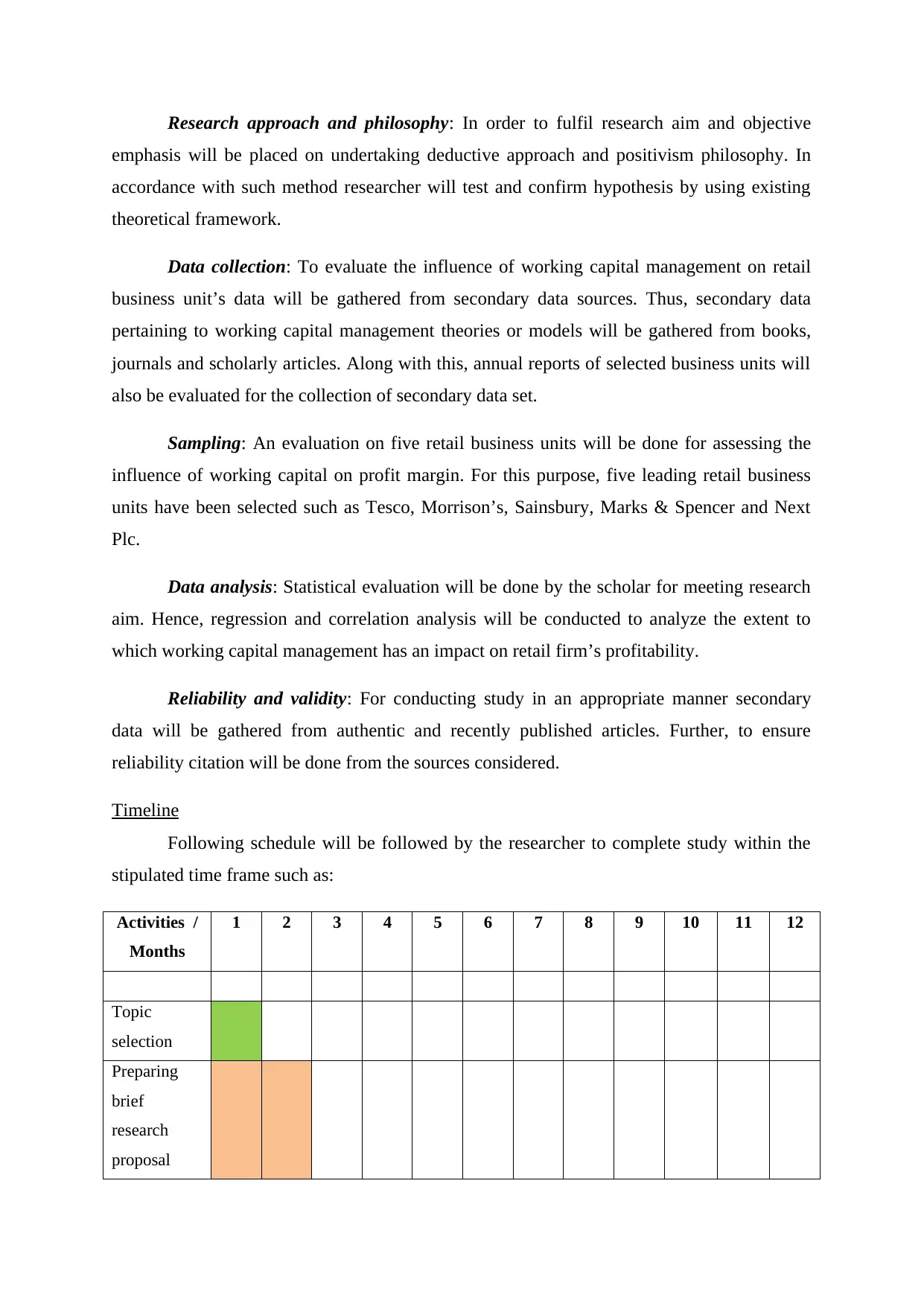
Research approach and philosophy: In order to fulfil research aim and objective
emphasis will be placed on undertaking deductive approach and positivism philosophy. In
accordance with such method researcher will test and confirm hypothesis by using existing
theoretical framework.
Data collection: To evaluate the influence of working capital management on retail
business unit’s data will be gathered from secondary data sources. Thus, secondary data
pertaining to working capital management theories or models will be gathered from books,
journals and scholarly articles. Along with this, annual reports of selected business units will
also be evaluated for the collection of secondary data set.
Sampling: An evaluation on five retail business units will be done for assessing the
influence of working capital on profit margin. For this purpose, five leading retail business
units have been selected such as Tesco, Morrison’s, Sainsbury, Marks & Spencer and Next
Plc.
Data analysis: Statistical evaluation will be done by the scholar for meeting research
aim. Hence, regression and correlation analysis will be conducted to analyze the extent to
which working capital management has an impact on retail firm’s profitability.
Reliability and validity: For conducting study in an appropriate manner secondary
data will be gathered from authentic and recently published articles. Further, to ensure
reliability citation will be done from the sources considered.
Timeline
Following schedule will be followed by the researcher to complete study within the
stipulated time frame such as:
Activities /
Months
1 2 3 4 5 6 7 8 9 10 11 12
Topic
selection
Preparing
brief
research
proposal
emphasis will be placed on undertaking deductive approach and positivism philosophy. In
accordance with such method researcher will test and confirm hypothesis by using existing
theoretical framework.
Data collection: To evaluate the influence of working capital management on retail
business unit’s data will be gathered from secondary data sources. Thus, secondary data
pertaining to working capital management theories or models will be gathered from books,
journals and scholarly articles. Along with this, annual reports of selected business units will
also be evaluated for the collection of secondary data set.
Sampling: An evaluation on five retail business units will be done for assessing the
influence of working capital on profit margin. For this purpose, five leading retail business
units have been selected such as Tesco, Morrison’s, Sainsbury, Marks & Spencer and Next
Plc.
Data analysis: Statistical evaluation will be done by the scholar for meeting research
aim. Hence, regression and correlation analysis will be conducted to analyze the extent to
which working capital management has an impact on retail firm’s profitability.
Reliability and validity: For conducting study in an appropriate manner secondary
data will be gathered from authentic and recently published articles. Further, to ensure
reliability citation will be done from the sources considered.
Timeline
Following schedule will be followed by the researcher to complete study within the
stipulated time frame such as:
Activities /
Months
1 2 3 4 5 6 7 8 9 10 11 12
Topic
selection
Preparing
brief
research
proposal
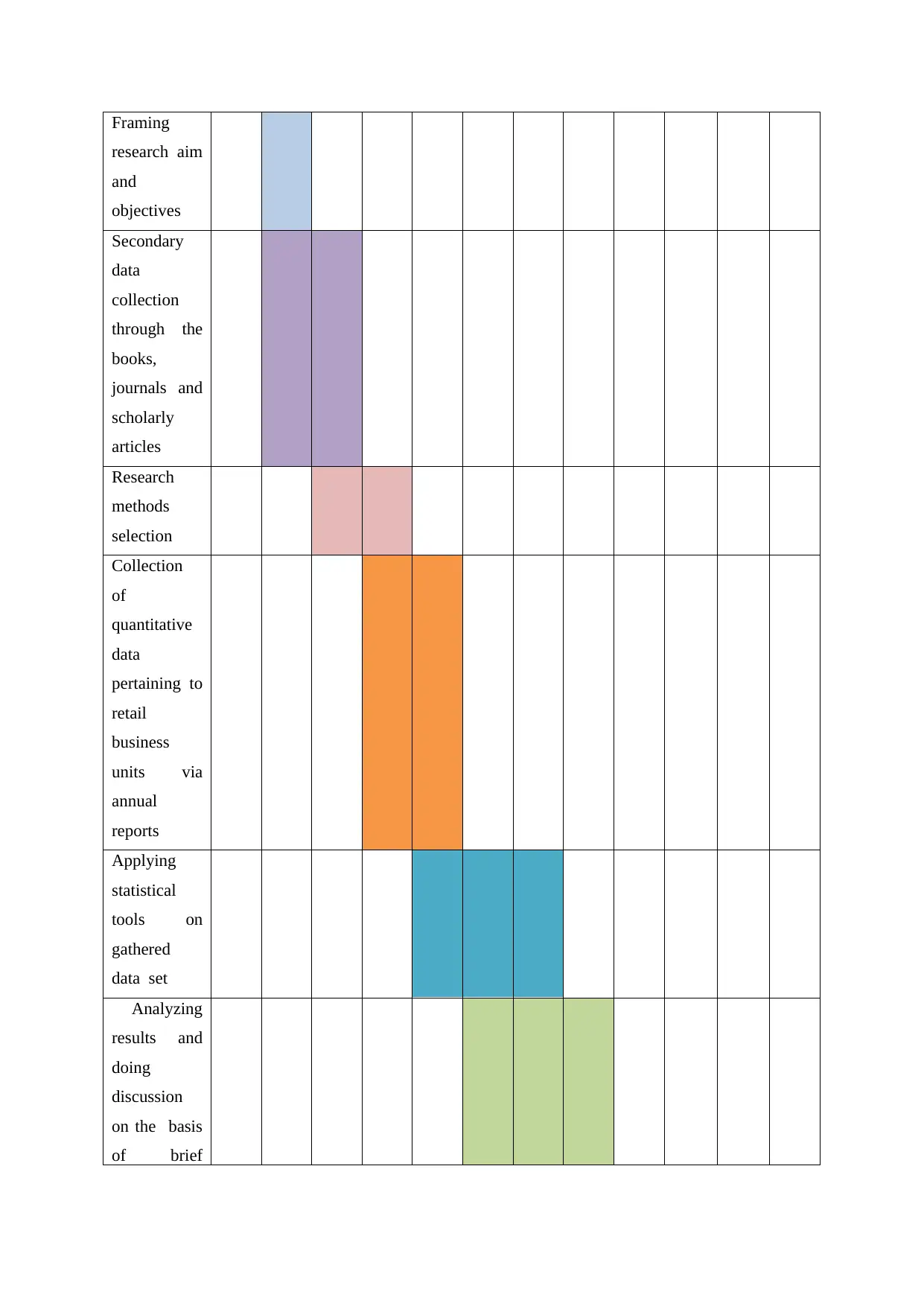
Framing
research aim
and
objectives
Secondary
data
collection
through the
books,
journals and
scholarly
articles
Research
methods
selection
Collection
of
quantitative
data
pertaining to
retail
business
units via
annual
reports
Applying
statistical
tools on
gathered
data set
Analyzing
results and
doing
discussion
on the basis
of brief
research aim
and
objectives
Secondary
data
collection
through the
books,
journals and
scholarly
articles
Research
methods
selection
Collection
of
quantitative
data
pertaining to
retail
business
units via
annual
reports
Applying
statistical
tools on
gathered
data set
Analyzing
results and
doing
discussion
on the basis
of brief
⊘ This is a preview!⊘
Do you want full access?
Subscribe today to unlock all pages.

Trusted by 1+ million students worldwide
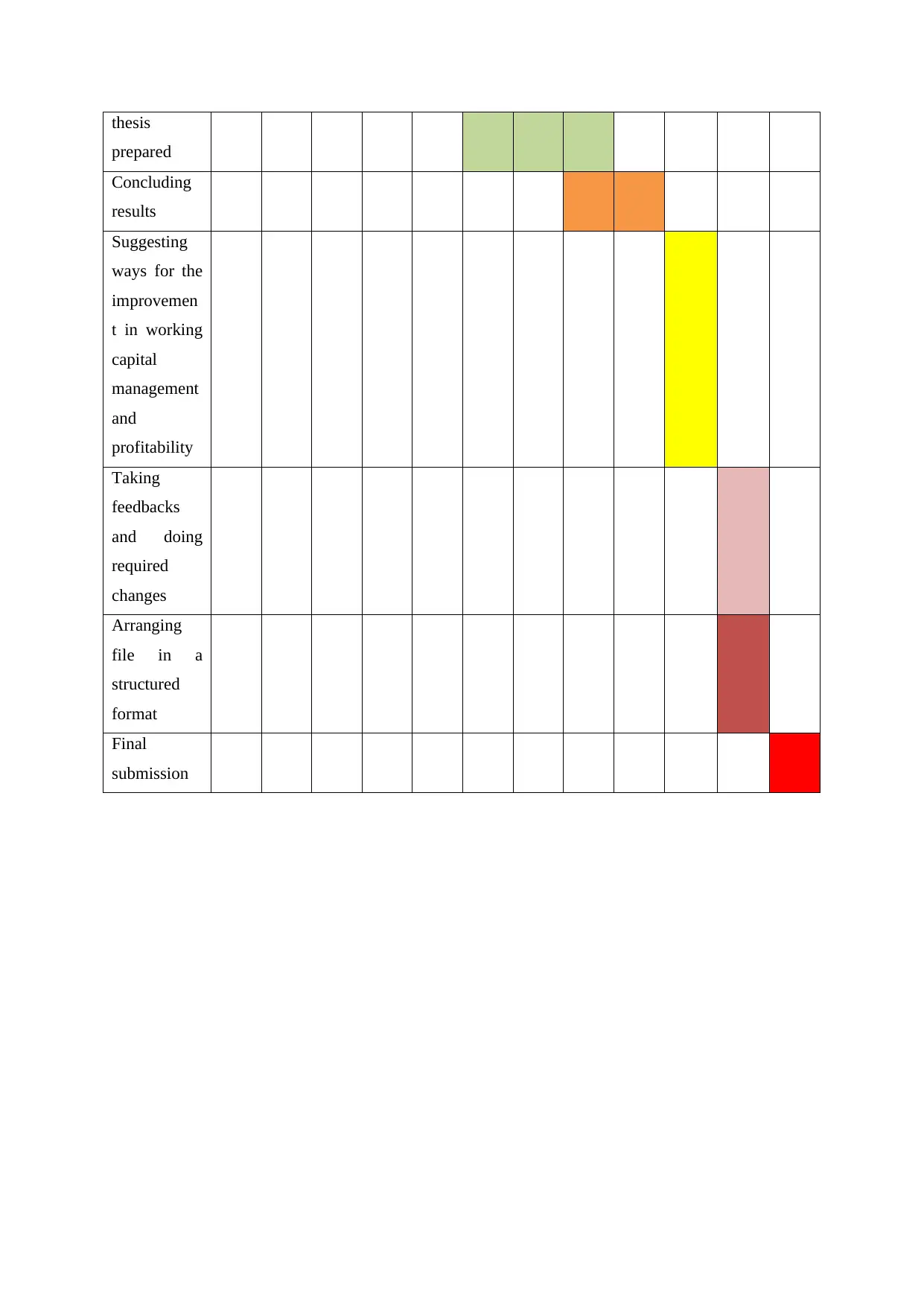
thesis
prepared
Concluding
results
Suggesting
ways for the
improvemen
t in working
capital
management
and
profitability
Taking
feedbacks
and doing
required
changes
Arranging
file in a
structured
format
Final
submission
prepared
Concluding
results
Suggesting
ways for the
improvemen
t in working
capital
management
and
profitability
Taking
feedbacks
and doing
required
changes
Arranging
file in a
structured
format
Final
submission
Paraphrase This Document
Need a fresh take? Get an instant paraphrase of this document with our AI Paraphraser
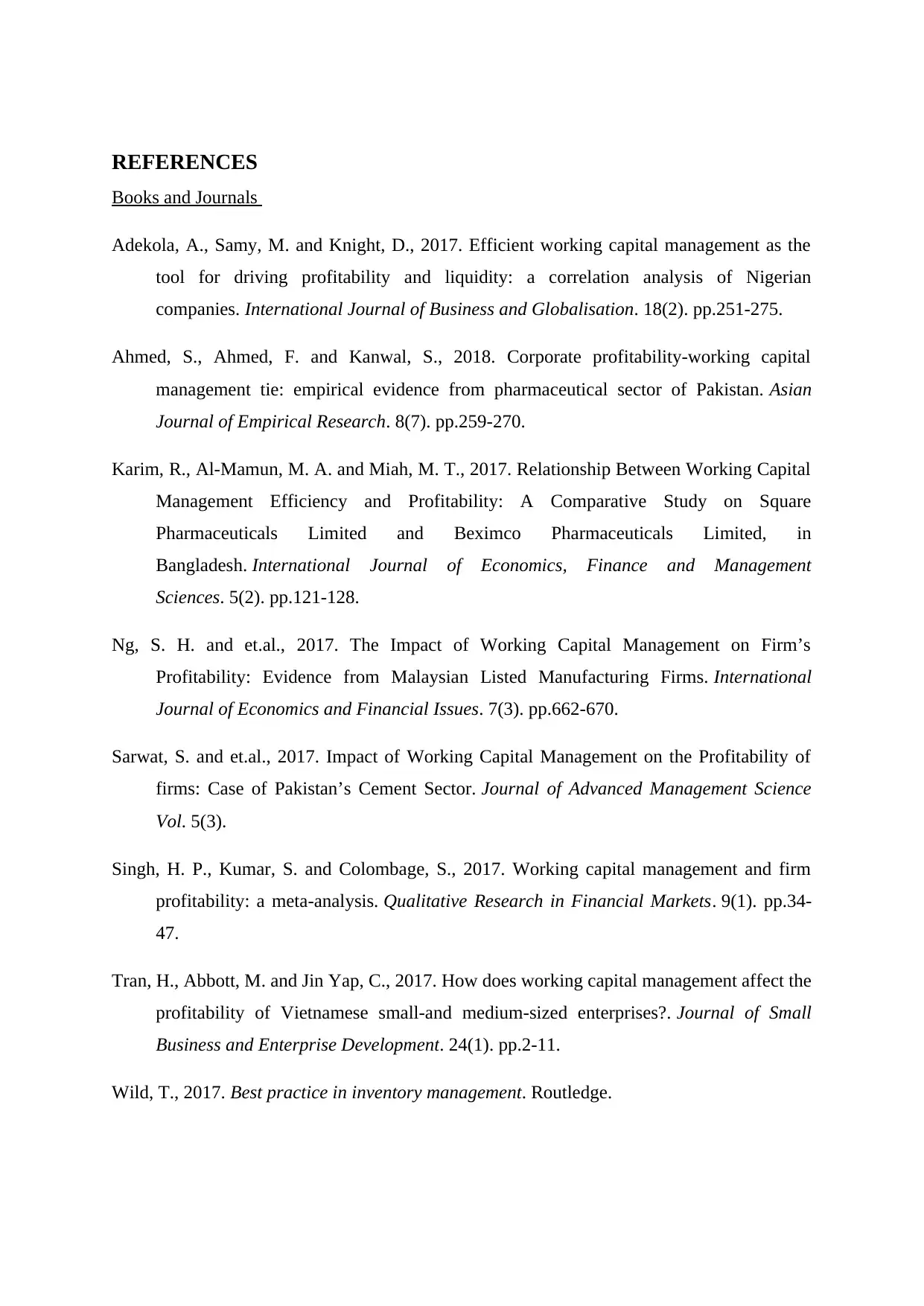
REFERENCES
Books and Journals
Adekola, A., Samy, M. and Knight, D., 2017. Efficient working capital management as the
tool for driving profitability and liquidity: a correlation analysis of Nigerian
companies. International Journal of Business and Globalisation. 18(2). pp.251-275.
Ahmed, S., Ahmed, F. and Kanwal, S., 2018. Corporate profitability-working capital
management tie: empirical evidence from pharmaceutical sector of Pakistan. Asian
Journal of Empirical Research. 8(7). pp.259-270.
Karim, R., Al-Mamun, M. A. and Miah, M. T., 2017. Relationship Between Working Capital
Management Efficiency and Profitability: A Comparative Study on Square
Pharmaceuticals Limited and Beximco Pharmaceuticals Limited, in
Bangladesh. International Journal of Economics, Finance and Management
Sciences. 5(2). pp.121-128.
Ng, S. H. and et.al., 2017. The Impact of Working Capital Management on Firm’s
Profitability: Evidence from Malaysian Listed Manufacturing Firms. International
Journal of Economics and Financial Issues. 7(3). pp.662-670.
Sarwat, S. and et.al., 2017. Impact of Working Capital Management on the Profitability of
firms: Case of Pakistan’s Cement Sector. Journal of Advanced Management Science
Vol. 5(3).
Singh, H. P., Kumar, S. and Colombage, S., 2017. Working capital management and firm
profitability: a meta-analysis. Qualitative Research in Financial Markets. 9(1). pp.34-
47.
Tran, H., Abbott, M. and Jin Yap, C., 2017. How does working capital management affect the
profitability of Vietnamese small-and medium-sized enterprises?. Journal of Small
Business and Enterprise Development. 24(1). pp.2-11.
Wild, T., 2017. Best practice in inventory management. Routledge.
Books and Journals
Adekola, A., Samy, M. and Knight, D., 2017. Efficient working capital management as the
tool for driving profitability and liquidity: a correlation analysis of Nigerian
companies. International Journal of Business and Globalisation. 18(2). pp.251-275.
Ahmed, S., Ahmed, F. and Kanwal, S., 2018. Corporate profitability-working capital
management tie: empirical evidence from pharmaceutical sector of Pakistan. Asian
Journal of Empirical Research. 8(7). pp.259-270.
Karim, R., Al-Mamun, M. A. and Miah, M. T., 2017. Relationship Between Working Capital
Management Efficiency and Profitability: A Comparative Study on Square
Pharmaceuticals Limited and Beximco Pharmaceuticals Limited, in
Bangladesh. International Journal of Economics, Finance and Management
Sciences. 5(2). pp.121-128.
Ng, S. H. and et.al., 2017. The Impact of Working Capital Management on Firm’s
Profitability: Evidence from Malaysian Listed Manufacturing Firms. International
Journal of Economics and Financial Issues. 7(3). pp.662-670.
Sarwat, S. and et.al., 2017. Impact of Working Capital Management on the Profitability of
firms: Case of Pakistan’s Cement Sector. Journal of Advanced Management Science
Vol. 5(3).
Singh, H. P., Kumar, S. and Colombage, S., 2017. Working capital management and firm
profitability: a meta-analysis. Qualitative Research in Financial Markets. 9(1). pp.34-
47.
Tran, H., Abbott, M. and Jin Yap, C., 2017. How does working capital management affect the
profitability of Vietnamese small-and medium-sized enterprises?. Journal of Small
Business and Enterprise Development. 24(1). pp.2-11.
Wild, T., 2017. Best practice in inventory management. Routledge.
1 out of 8
Related Documents
Your All-in-One AI-Powered Toolkit for Academic Success.
+13062052269
info@desklib.com
Available 24*7 on WhatsApp / Email
![[object Object]](/_next/static/media/star-bottom.7253800d.svg)
Unlock your academic potential
Copyright © 2020–2025 A2Z Services. All Rights Reserved. Developed and managed by ZUCOL.





